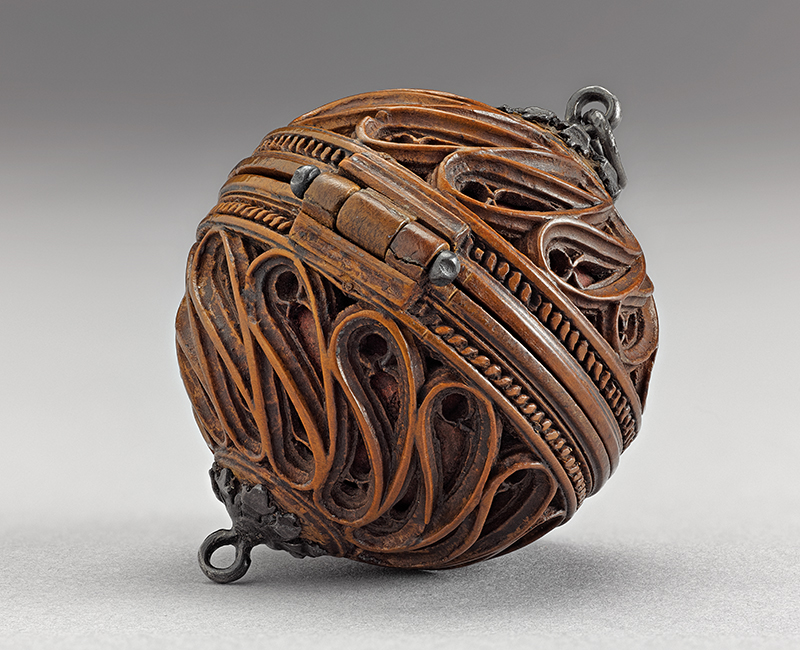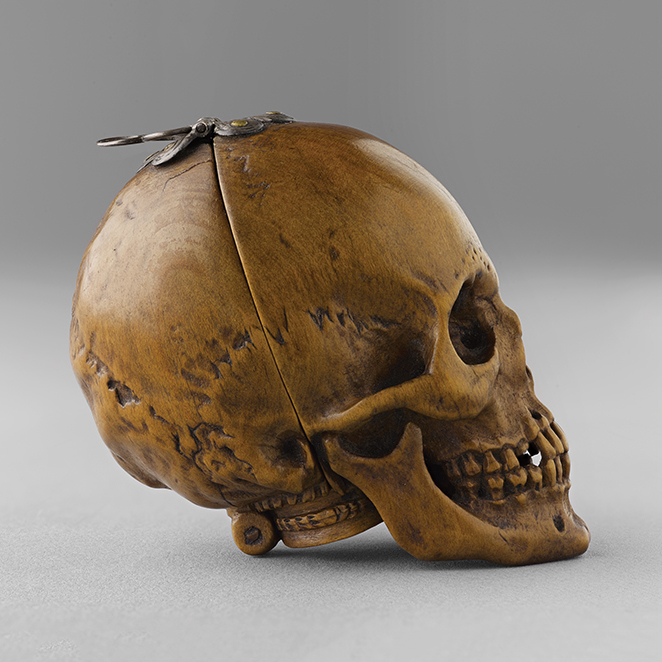When viewing the objects, one tumbles headlong into astonishing miniature worlds created by their carver. The effect is, perhaps, not unlike obsessive attention to smartphones and the world they reveal beyond one’s immediate surroundings. There is an Alice-in-Wonderland quality to these prayer beads: a means of escape from the present. That kind of fascination does not depend on adherence to a religious creed, and that, combined with private rather than public ownership, seems to lie at the root of preservation of Gothic boxwood carvings to the present day.

A prayer bead in the Thomson Collection (AGO 29363) pictures Jesus chasing money lenders and merchants out of The Temple in Jerusalem in its upper half and his later entry into Jerusalem on Palm Sunday in the lower half. This pairing is rare in the corpus of gothic boxwood carving, but both scenes were often portrayed in late medieval art. What makes this prayer bead special is the tiny bird cage held by the woman fleeing right in front of Jesus. Behind the curved cage bars are several tiny doves carved in full round. When the prayer bead is moved in the hand of its user, the doves shake within their cage creating an astonishing kinetic effect. How did the maker of this prayer bead accomplish the feat of carving the doves behind bars? In an otherwise simple scene, this little detail was almost certainly included to inspire wonder in the original viewers.
Collecting
The survival of such a large corpus of these small and delicate objects—and the evidence of later, specially crafted containers to house them safely—indicates a chain of dedicated owners who have cherished and protected them. Sometimes these were family heirlooms, passed down from generation to generation; seldom, however, can the chain be completely reconstructed. Identifiable patrons owned or commissioned eleven of the surviving boxwood carvings. These include men and women, married couples, European royalty, Church officials, members of the Netherlandish aristocracy and of the exclusive and distinguished Order of the Golden Fleece. While some carvings were acquired as unique examples of their types, others were collected obsessively in large groups.

Prayer beads functioned as wonderful gifts that could be personalized for their owners. A beautiful prayer bead in a private collection (pictured above and to the left) was given to François Du Puy by a colleague from another city. Du Puy is pictured kneeling next to the order’s patron saint and founder, St. Bruno, in the upper scene within. Fittingly, the inscription in the banderole just left of his hands reads: “meme[n]to: d: Fra[n] de puteo” (memory of François Du Puy). When Petrus Blomevenna visited Du Puy in Grenoble, Du Puy gave him relics from St. Bruno to take home to Cologne. It is likely that Blomevenna commissioned this prayer bead as a gesture of thanks for Du Puy. [45]
A prayer bead in the shape of a skull from the Thomson Collection (AGO 29283), possibly made of a fruitwood like pear or apple wood, was made for the renowned collector and Cardinal Albrecht of Mainz. A latch that holds the prayer bead closed features the heraldic emblem of Albrecht on the outside. Beneath that latch is the mysterious mark of an unknown merchant—likely the person who gifted Albrecht the prayer bead.
Wunderkammers
Comprised of wonders of nature, art objects, foreign curiosities and technical instruments, as well as “images of sacred history,” [46] sixteenth-century “Cabinets of Art and Marvels” were perfect homes for sixteenth-century boxwood carvings. [47] The virtuosic carving technique that they required clearly impressed the authors of the inventory of the dukes of Bavaria, who were among the earliest collectors. [48] The 1598 inventory of their treasury mentions several boxwood carvings. One is distinguished as “a subtly carved ball of boxwood.” [49] The description reflects the sense of marvel that these objects awakened. The dukes lacked the full technical means to unravel the secrets of carving these objects that we now have, but some aspects of the carver’s art would surely have been discerned by these collectors, for woodworking was a hobby among the Bavarian nobility. [50] Duke Wilhelm V (ruled 1579–1597), a devout Roman Catholic and a significant patron of art and architecture, might have acquired the boxwood beads, but his predecessor Albrecht V (ruled 1550–1579) is a more compelling candidate. [51] He was a particularly ambitious collector who worked closely with his Flemish advisor Samuel Quiccheberg to build an encyclopedic collection of art and wonders at his palace in Munich. In 1565, Quiccheberg penned a treatise of global ambition, the Inscriptions or Titles of the Most Ample Theatre that Houses Exemplary Objects and Exceptional Images of the Entire World, containing instructions for the foundation of a princely collection. [52] Sacred images were to be an integral part of the holdings. Another essential component was a workshop of turning and joining tools considered by “princes and patricians to belong to the domain of the more congenial arts.” [53] The installation, therefore, should provide an understanding of
technique, “so that, beyond their ornamentation and elegance (which are here present to the highest degree), a not trifling delight is experienced.” [54] A similar, almost fetishizing fascination with technique is encapsulated in the precious collection of tools and boxwood carvings of Ottaviano Jannella.

Collecting in the nineteenth century: Searching for the infinitely small
Over one hundred of the surviving gothic boxwood carvings surfaced in nineteenth-century Paris. In that period, buyers and sellers alike flocked to the French capital and engaged with the city’s thriving medieval and Renaissance art market. A looming figure on the Parisian antiquarian market was Vienna-born Frédéric Spitzer (1815–1890). Spitzer commissioned metalsmiths in Aachen and Paris to produce modern works of art inspired by and often slavishly copied from originals to augment their number.55 Four surviving boxwood carvings were altered by Spitzer for the market. [56] One of these examples survives in the Thomson Collection: the Carrying of the Cross (AGO 107464), which had its nineteenth-century triptych wings removed at an unknown date and is displayed to today’s audiences accordingly. It is evident that the original parts are missing, but the virtuosic quality of the carving remains intact.
Their achievements seem almost miraculous
The American financier J. Pierpont Morgan bought collections en bloc as well as single works of art. On April 13 1906, he purchased Baron Oppenheim’s entire collection in London with the intention of bringing it directly to New York, but he was hindered by tariffs on importing works of art. [57] His Oppenheim purchase included four boxwood carvings: one triptych with the Crucifixion and Resurrection (MMA 17.190.453), another with the Crucifixion and the Carrying of the Cross, a prayer bead with the Carrying of the Cross (MMA 17.190.473a) and the Crucifixion (MMA 17.190.473b) and finally a medallion, unusual in representing the Feast of Ahasuerus (MMA 17.190.471). A boxwood diptych featuring the Nativity and the Mass of St. Gregory (MMA 17.190.476) was purchased by Morgan in 1898 from Charles Mannheim, and remains a cornerstone of the Morgan medieval collection at The Met. All of these works are illustrated in a 1910 catalogue of Morgan’s collection. [58] By 1914, the guide to the Morgan collection records two cases of boxwood in the medieval galleries. Regarding their carvers it was observed that “their achievements seem almost miraculous.” [59] Here the two strains underlying the collecting of these objects merge in a single sentence. Yes, they are “miraculous,” as their original owners prayed they would be; but “almost miraculous” is the assessment of the artist’s capability.

The quality of the carving ... can come through ... the touch
A marked interest in boxwood carvings persisted even after the industrialist collectors of the late nineteenth and early twentieth centuries died and their collections passed to institutions. A smaller number have been sold through private dealers. The principals of the Blumka Gallery, active in New York ever since the Nazi annexation of Austria obliged the family to relocate there from Vienna, evince a special interest in boxwood carvings, offering some of the most notable examples in the late twentieth and early twenty-first centuries. These include the prayer bead depicting the Queen of Sheba in the Thomson collection (AGO 29458), a prayer bead in the Smith College Museum, and a triptych with the Virgin of the Apocalypse in a private collection in the United Kingdom. The owner of the triptych expresses his fascination with boxwood carvings in much the same vein as the princely collectors of the past: “I love the intricacy of these miniature carvings which are so like ivory carving. They are true marvels and inspire wonder.” [60]

The most committed collector of boxwood carving in the twentieth and twenty-first centuries was, without a doubt, the Canadian publishing magnate Ken Thomson (1923–2006). Thomson’s collecting career began at the age of 30, in 1953, and continued until his death. Through his close friendship with the German-born, London-based dealer Hermann Baer, he developed a connoisseur’s eye and a love of small sculpture. Together Baer and, later, the English dealer Sam Fogg advised Thomson on the acquisition of precious medieval and Renaissance works of art, helping him to amass the largest group of boxwood carvings in the world: six prayer beads, two skulls, and two triptychs (one which has lost its outer wings). Thomson purchased his first boxwood devotional carving in 1969. [61] His family continues to collect these works in honour of their father, and indeed, three additional works can be considered part of the latter’s legacy. Ken Thomson’s collection of over 800 examples of European precious works of medieval and Renaissance art at the Art Gallery of Ontario represents his love of miniature, virtuoso works of art: “As you know, I like small works of art, small sculptures, usually in boxwood or ivory and in materials that largely are organic and they feel good. When I say they feel good, the quality of the carving, of the execution, can come through not only through the eye but through the touch.” [62] In addition to his admiration for small-scale craft, Thomson expressed the tactile appeal to which the United Kingdom collector also alluded in comparing them to ivory carving. Thomson articulates a special, almost spiritual link that he feels—not to the actors in the Christian drama who appear in the beads—but to the artist who created them: “How did he ever end up doing this? It defies my imagination.” [63]
This Essay excerpted from Small Wonders: Gothic Boxwood Miniatures
Notes
[45] Scholten 2011.
[46] Pilaski 2013, 21 and 122–27, emphasizes the role of religious imagery in the context of the Kunstkammer.
[47] For a thorough history of the Kunstkammer see Impey and MacGregor 1985.
[48] Seelig 1985.
[49] Diemer et al. 2008, vol. 1, nos. 370–73.
[50] Quiccheberg 1565, 27.
[51] Maxwell 2011, 1; Schlosser 1978, 142–43 (fig. 96) (cited in Romanelli 1992, 204,cat. no. 2); a second prayer bead entered the Schatzkammer collection in 1846. See Romanelli 1992, 306, cat. no. 41.
[52] See Quiccheberg 1565; Pilaski 2013. In Munich, Albrecht V and Quiccheberg designed a building that could accommodate visitors. See Petzet 1986, 16–36.
[53] Quiccheberg 1565, 72.
[54] Ibid, 72.
[55] Distelberger et al. 1993, 282–87, 2012.
[56] Molinier and Pabst 1891.
[57] “Mr. Morgan’s Old Carvings; Baron Oppenheim’s Collection Bought by J. Pierpont Morgan Is Shown to London, But Not to New York—Our Ridiculous Tariff Prevents Bringing Over Ancient Statues and Reliefs,” New York Times (18 November 1906).
[58] Williamson 1910.
[59] Ibid, 77.
[60] Personal communication between A. Suda and B.D. Boehm, 2016.
[61] At the Melvin Gutman sale, New York, 24 April 1969.
[62] K. Thomson with A. Barrie, CBC Metro Morning, Canadian Broadcasting Corporation (10 November 1997).
[63] See the AGO website, M. Teitelbaum and K.R. Thomson, “A Conversation with a Collector” (21 July 1992).